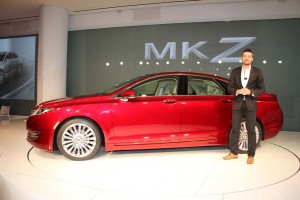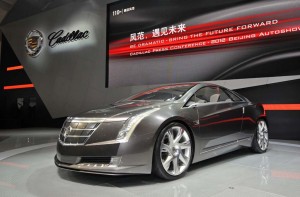They were once the benchmarks of the luxury market but today, Detroit’s Cadillac and Lincoln brands struggle in the shadows of better-known imports like Lexus, Mercedes-Benz and BMW, the latter now the world’s largest premium automotive manufacturer.
But the coming months could be critical for the two domestic luxury marques as they both launch critical products that could help redefine their brands – and as they prepare for the critical step of going global.
For Caddy, the 2013 model-year brings the launch of the big XTS and, arguably more important, the ATS, a compact sedan challenging the likes of the segment-defining BMW 3-Series.
As for its cross-town rival, Ford Motor Company’s luxury division is set to launch the first of four major new products, the MKZ, which Rich Kreder, the program’s Vehicle Integration Manager, calls, “The first really important step in redefining Lincoln.”
Challenging the Japanese and German brands that dominate the luxury market clearly won’t be easy, officials at both Cadillac and Lincoln admit. But they have no real choice. Accepting the status quo, as secondary players largely limited to the North American market, is a self-defeating proposition.
It’s long been said that only three things matter in the automotive world: product, product and product. That’s all the more true today, especially as the Germans, a group also including surging Audi, introduce a veritable alphanumeric soup of new offerings, such as the upcoming Mercedes CLA compact coupe-like sedan and BMW’s i3 and i8 battery cars.
There’s also the matter of economies of scale, adds Mark Reuss, president of GM’s North American operations. The more cars you sell the lower your piece costs and the more vehicles you have to spread fixed costs – such as product development and factory operations – over.
So, delivering a strong product like the well-reviewed ATS is essential. Expect to see Cadillac come up with still more new offerings over the next several years. These range from a complete remake of the big Escalade SUV to the polar opposite ELR compact plug-in hybrid that will reach market in mid-2013.
“We’re going to take chances,” promises Reuss during a luncheon for members of the influential North American Car of the Year jury (of which this reporter is one). “Not stupid chances. Not train-wreck chances, but chances we need to take.”
Other products reportedly either in development or likely to be approved soon include:
- One or more “flagship” models, at least one to be loosely based on the widely respected 2011 Cadillac Ciel concept;
- Cadillac’s first convertible since the failed Allante that was abandoned in 1993;
- A crossover-utility vehicle – possible two – smaller than the current Caddy SRX.
That’s still a lot less product variation than the Germans already offer, but Reuss insists the goal is “not to try to have the most models (but) to have the best vehicles.”
Lincoln officials say essentially the same thing when reminded Mercedes’ crossover line-up alone will is about as big as the entire model mix the Ford subsidiary plans by mid-decade. But Matt Van Dyke, Lincoln’s new global launch director, also hints that if the MKZ and the next couple products to come do well in the market there could be money found to add even more offerings in relatively quick order.
Of the two domestic luxury brands, analyst Jim Hall, of 2953 Analytics, contends Caddy is “an established luxury brand, albeit one that’s struggling to rebuild its past glory. Lincoln, on the other hand, is a “nascent luxury brand…that hasn’t defined itself” after years of searching for a clear identity.
It has variously tried to position itself as the definition of “American” luxury, as a serious Euro-fighter and even as a “blue-collar” luxury brand. It didn’t help that, under former CEO Jacques Nasser, Ford acquired an assortment of high-line European marques such as Aston Martin and Jaguar and seemed to lose interest in its home-grown brand.
With all those foreign makers gone, Ford either has to make Lincoln viable again or dispatch it the way it did Mercury and accept that Ford will be a one-brand, mainstream company.
Ford is shifting more resources to Lincoln, which now gets its own design team, a separate PR and marketing operation – and which now has global marketing czar Jim Farley given the added assignment of being the brand’s director. He previously served as head of Toyota’s Lexus before joining Ford six years ago. A key project for Farley will be leading the charge into China, the anticipated first step in going truly global.
Robert E. Ferguson will be tasked with the same move by Cadillac. Caddy has had a modest presence in the booming Asian market – and other parts of the world – but it now wants to step out of the shadows and be a major force in what is the globe’s fastest-growing luxury car market. Of course, it helps that GM is already the biggest automaker there.
But, ironically, what has served Caddy well in the States is proving a problem in China, notes analyst Hall. “Cadillac has been consistent in showing what it wants to be,” especially with its decade-long commitment to the edgy Art & Science design language introduced on the first-generation CTS sedan. “But that doesn’t play well in China,” Hall and others point out.
While Chinese buyers have been open to cutting edge styling, that has been largely in the mainstream market. In higher segments, however, consumers there have shown a preference for more subdued, European-style designs.
As a result, the next generation of Cadillac products are reportedly set to sand off some of their edges in line with GM CEO Dan Akerson’s comment at the Beijing Motor Show that, “Successful global automotive companies must have a major global luxury brand that … wins around the world, and in China.”
Akerson also confirmed Caddy will begin producing the new ATS in China to sidestep import tariffs. Other models will follow.
So, ironically, it’s only by stretching well beyond the home market that Detroit’s two remaining luxury auto brands may find a successful future. They have little choice but to reinvent themselves in line with the modern realities of a global market.


